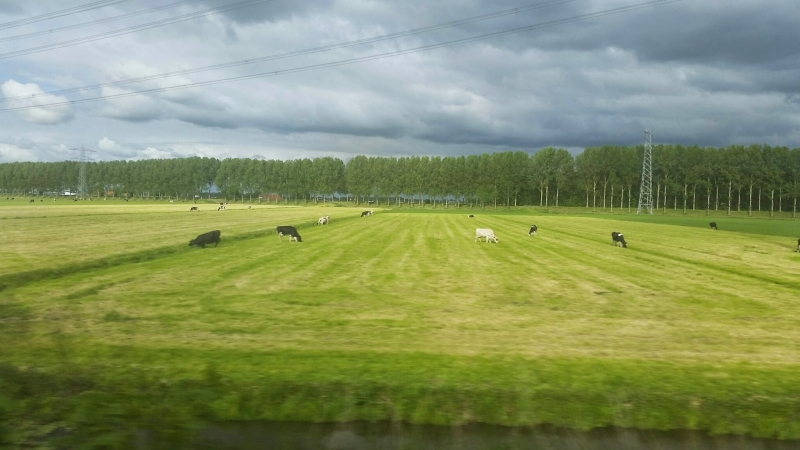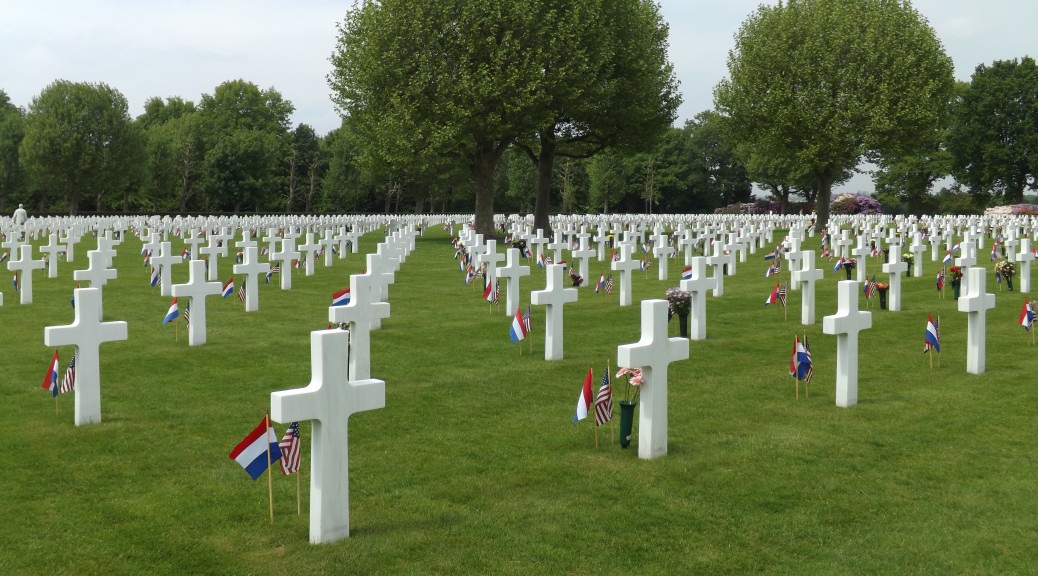After living in, and traveling throughout Western Europe for six months I find myself constantly reminded of ways in which Europe still lives in the shadow of World War II. In some ways it’s very passive, such as a yearly paid holiday in France to mark V-E day. Sometimes you have to look for it, like touring museums, rebuilt cities, or concentration camps. While other times it can be in-your-face, such as recovering unexploded bombs yet to this day in London.
For Memorial Day 2015, Phil and I witnessed a personal version of these remembrances in The Netherlands. For over seventy years, since the Nazis were pushed out of The Netherlands and the allies first moved into German territory, Dutch families have stood vigil over the graves of American soldiers in Margraten.
Before moving to Switzerland, my Grandma Johnson told me that her brother, Harold Raske (my great uncle) who died in WWII, was buried in The Netherlands. So, as we were planning our trip to Amsterdam, a little bit of Google sleuthing led me straight to the location of his grave – The Netherlands American Cemetery near Margraten, Plot F, Row 10, Grave 18. To reach Margraten we would need to take a three-hour-long train ride to the extreme south east corner of the Netherlands, just a few miles from the German border. But considering the thousands of miles and many years that separated Harold from Cosmos, MN, it seemed like a relatively easy trip for us to make.
The train ride through the Dutch country side was rather unremarkable. The scenery could have been easily confused as a stretch of central Iowa or Nebraska if it weren’t for the Dutch and German chatter around us. The landscape was a lush green of very flat fields often covered with ambling sheep and cattle. The train went only as far as the town of Maastricht, where we found a bus that would drop us off directly in front of the cemetery.

It was by coincidence in our schedule that we could visit on Memorial Day, and when we climbed on the bus it quickly became apparent that other Americans were making the same pilgrimage as us as they climbed aboard speaking English and holding bouquets of flowers. As the bus crept along a rural highway, I was quickly struck by how similar the rolling green fields were to those that I, and I’m sure Harold, knew from Minnesota. Sometimes all it takes is a smiling picture posted on Facebook for me to feel the soft pang of homesickness, so in some small way it was reassuring for me to know that even in the middle of deadly and disorienting chaos, Harold had some way, however insignificant, to be reminded of his home.
The gates to the cemetery were nearly overwhelmed with both foot and car traffic. We walked down the winding gravel path to the beautiful memorial erected to honor those who had fought and died in Europe. Flanking a peaceful reflection pond were two walls filled with the names of those whose bodies were never found. At one end of the reflection pool was a tower that houses a small chapel with a statue representing a mother grieving her son. Off to the side there was also a visitors center that we stopped at to find directions to Harold’s grave. We were immediately asked if the grave we were searching for was a family member. When I said, “Yes”, the guide manning the front desk grabbed his keys, coat, and a bucket of sand to personally escort us out.
Along the walk through the thousands of white marble crosses and stars of David, he told us a bit of history about the site. Many of the soldiers buried here were a part of the unsuccessful ‘Operation Market Garden,’ an operation made better known by the movie and novel A Bridge Too Far. We were informed that prior to engagement, these soldiers were promised that should they fall, they would not be buried behind the nearby enemy lines, so all causalities were sent back to Margarten to be buried by locals. Ultimately 19,304 men were buried there, but this site is the final resting place for only 8,301 as many families requested for remains to be sent back home. (More historical information can be found here: http://www.abmc.gov/sites/default/files/publications/Netherlands_Booklet.pdf)
As we approached Harold’s maker, we noticed that many of the white crosses and stars were adorned with different assortments of flowers. Harold’s marker had a cheerful pot of purple daisies, and was otherwise immaculate. The guide had us rub sand, taken from the beaches of Normandy, into the engravings on the marble cross for contrast. He then took a digital picture, which he later printed out to give us, along with a large packet of informational materials. He then left us to explore the grounds and flowers. We ambled along the sidewalks and soaked in the peaceful atmosphere. Near the front of the cemetery was a large set of bleachers and collection of floral arrangements. A day earlier, they had commemorated “Liberation Day,” a service that includes the presentation of a few dozen floral wreathes, and this year, had even featured a speech by the Dutch prime minister; we were told that this event regularly attracts 7,000 visitors.
What impressed me the most, however, were the unique bouquets or pots of flowers at every single marker. Shortly after this cemetery was established, the city of Margraten decided to honor their liberators by having a family adopt each and every grave. The family would personally visit the grave several times a year and bring fresh flowers during the warmer months. Occasionally the family would know the fallen soldier, but more often than not, all they knew was that another man had selflessly and literally laid down his life for their freedom. Sometimes these adopters had contact with the remaining family of the soldier, though even more of these adopters know little more than a name, date of death, and a state of birth. Some of these graves are still tended by people who remember Nazi occupation, but in many cases, a grave has been passed down from generation to generation. Even a full 70 years later, there is a waiting list of people who would be honored for the opportunity to remember these Americans. (The Washington Post just published a wonderful article about this, please take the time to read: http://www.washingtonpost.com/local/americans-gave-their-lives-to-defeat-the-nazis-the-dutch-have-never-forgotten/2015/05/24/92dddab4-fa79-11e4-9ef4-1bb7ce3b3fb7_story.html?tid=pm_pop_b)
It is astounding how such a simple, yet incredibly meaningful, act can be compounded across generations. In the U.S., the vast majority of citizens live without the reminder of what war really is or can be. Of course we dutifully pay tribute to those who have died and served, and for the vast majority of citizens (thankfully), this tribute is paid without the crushing burden of loss. Across Europe, however, is a population who’s lives would not exist as they do now without the sacrifice of their own family, countrymen, and foreign strangers who found themselves thousands of miles away from home. It seems nearly impossible to find a family here who, two or three generations ago, had not been touched in some meaningful way by the atrocious violence that was WWII. Accompanying that loss, however, is a powerful force for remembrance, one that even 71 years later touches the life of a family living in rural Minnesota.




Melissa, what a well written blog. It brought me to tears. A friend of mine went on a WWII tour all thru Europe and they had two WWII vets with them. When many European people, including a young group of men, would find out they were WWII vets, they would stop and shake their hands and thank them profusely. When towns and cities would got wind that WWII vets were coming, they would hold banquets and receptions for them. They said it was truly amazing how much the Europeans still are so grateful to the Americans.
I missed reading this one! Thank you, Melissa, for sharing about your Memorial trip to the Netherlands. How amazing the guide took the time to show you the marker – and brought the sand so the etching would show. I cannot fathom the Gratitude they have for the soldiers and yes, the memory of WWII that happened right there. The only things I learned about WWII were from school books and movies…to actually be in a location where the battles took place, how fortunate! Enjoy the journey – and yes, the countryside pictures do resemble Minnesota.